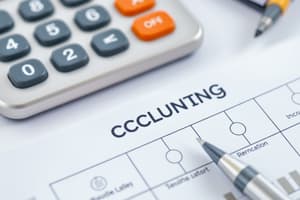Podcast
Questions and Answers
What is the primary purpose of the accounting cycle?
What is the primary purpose of the accounting cycle?
- To journalize transactions in a ledger
- To prepare financial statements for stakeholders (correct)
- To record and process financial transactions only
- To identify and record transactions only
Which step in the accounting cycle involves recording transactions in a chronological record?
Which step in the accounting cycle involves recording transactions in a chronological record?
- Prepare Trial Balance
- Journalize Transactions (correct)
- Identify and Record Transactions
- Post Journal Entries to Ledger
What is the purpose of preparing an adjusted trial balance?
What is the purpose of preparing an adjusted trial balance?
- To prepare financial statements
- To close temporary accounts
- To reflect changes in account balances due to depreciation and accruals (correct)
- To identify and record transactions
Which type of accounts are closed in the accounting cycle?
Which type of accounts are closed in the accounting cycle?
What is the final step in the accounting cycle?
What is the final step in the accounting cycle?
What is the purpose of the trial balance in the accounting cycle?
What is the purpose of the trial balance in the accounting cycle?
Flashcards are hidden until you start studying
Study Notes
Accounting Cycle Overview
The accounting cycle is a series of steps used to process and record financial transactions, resulting in financial statements that provide stakeholders with a clear picture of a company's financial position and performance.
Steps in the Accounting Cycle
- Identify and Record Transactions: Identify and record all financial transactions, including cash receipts, cash payments, sales, purchases, and other business events.
- Journalize Transactions: Record transactions in a journal, which is a chronological record of all transactions.
- Post Journal Entries to Ledger: Transfer journal entries to a ledger, which is a book of accounts that contains all the financial transactions.
- Prepare Trial Balance: Prepare a trial balance, which is a list of all general ledger accounts and their corresponding debit or credit balances.
- Prepare Adjusting Entries: Prepare adjusting entries to reflect any changes in account balances, such as depreciation or accruals.
- Prepare Adjusted Trial Balance: Prepare an adjusted trial balance, which reflects the changes made by adjusting entries.
- Prepare Financial Statements: Prepare financial statements, including the balance sheet, income statement, and cash flow statement.
- Close Accounts: Close temporary accounts, such as revenue and expense accounts, and transfer their balances to permanent accounts.
- Prepare Post-Closing Trial Balance: Prepare a post-closing trial balance to ensure that all accounts have been properly closed.
Importance of the Accounting Cycle
- Provides a systematic approach to recording and reporting financial transactions
- Ensures accuracy and reliability of financial statements
- Facilitates internal control and decision-making
- Enhances transparency and accountability
Key Concepts
- Assets: Resources owned or controlled by the business
- Liabilities: Debts or obligations owed by the business
- Equity: Residual interest or ownership in the business
- Revenue: Income generated from business operations
- Expenses: Costs incurred to generate revenue
- Debits: Increases in assets or decreases in liabilities and equity
- Credits: Decreases in assets or increases in liabilities and equity
Accounting Cycle Overview
- The accounting cycle is a series of steps that process and record financial transactions, resulting in financial statements that provide stakeholders with a clear picture of a company's financial position and performance.
Steps in the Accounting Cycle
- Identify and record all financial transactions, including cash receipts, cash payments, sales, purchases, and other business events.
- Record transactions in a journal, which is a chronological record of all transactions.
- Transfer journal entries to a ledger, which is a book of accounts that contains all the financial transactions.
- Prepare a trial balance, which is a list of all general ledger accounts and their corresponding debit or credit balances.
- Prepare adjusting entries to reflect any changes in account balances, such as depreciation or accruals.
- Prepare an adjusted trial balance, which reflects the changes made by adjusting entries.
- Prepare financial statements, including the balance sheet, income statement, and cash flow statement.
- Close temporary accounts, such as revenue and expense accounts, and transfer their balances to permanent accounts.
- Prepare a post-closing trial balance to ensure that all accounts have been properly closed.
Importance of the Accounting Cycle
- Provides a systematic approach to recording and reporting financial transactions.
- Ensures accuracy and reliability of financial statements.
- Facilitates internal control and decision-making.
- Enhances transparency and accountability.
Key Concepts
Assets
- Resources owned or controlled by the business.
Liabilities
- Debts or obligations owed by the business.
Equity
- Residual interest or ownership in the business.
Revenue
- Income generated from business operations.
Expenses
- Costs incurred to generate revenue.
Debits and Credits
- Debits: Increases in assets or decreases in liabilities and equity.
- Credits: Decreases in assets or increases in liabilities and equity.
Studying That Suits You
Use AI to generate personalized quizzes and flashcards to suit your learning preferences.




